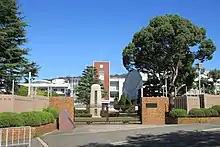Osaka school massacre
The Osaka school massacre was a mass murder that occurred at Ikeda Elementary School in Ikeda, Osaka Prefecture, Japan on 8 June 2001, in which Mamoru Takuma, a 37-year-old ex-convict with a history of mentally disturbed and anti-social behavior, stabbed eight students to death and seriously wounded fifteen others in a knife attack that lasted several minutes. Takuma was sentenced to death in August 2003 and executed in September 2004.
| Osaka school massacre | |
|---|---|
 Ikeda Elementary School | |
| Location | Ikeda, Osaka Prefecture, Japan |
| Date | June 8, 2001 |
Attack type | Mass murder, stabbing, school violence |
| Weapons | Kitchen knife |
| Deaths | 8[1] |
| Injured | 15 |
| Perpetrator | Mamoru Takuma |
Background
Mamoru Takuma was a 37-year-old ex-convict from Itami, Hyōgo Prefecture, who had a long history of mentally disturbed and anti-social behavior since childhood, and an extensive criminal record that included a conviction for rape. As a teenager, Takuma's volatile behavior led to him being kicked out of school and his father eventually disowning him. After being released from prison in 1989, Takuma moved to the nearby city of Ikeda, Osaka Prefecture, working various part-time jobs in the area but often being fired for erratic or violent behavior. In 1999, he was detained at a psychiatric hospital while working as a janitor at Itami City Ikejiri Elementary after slipping his temazepam into tea he served in a teachers' room at the school, resulting in staff being hospitalized. Takuma attempted to commit suicide at the psychiatric hospital, but was soon determined as fit to be released. In October 2000, Takuma was charged for assaulting a bellhop while working as a taxi driver in Osaka.
Attack
On 8 June 2001, at 10:15 a.m. local time, Takuma entered the elite Ikeda Elementary School, which was affiliated with Osaka Kyoiku University. Armed with a kitchen knife, he began stabbing school children and teachers at random, killing eight students aged between seven and eight, and seriously wounded another thirteen other children and two teachers.[2] Takuma was wrestled into submission by several staff members after a few minutes of rampaging, and began ranting incoherent statements.
Takuma had committed the massacre the day of his court hearing for assaulting the bellhop in October 2000.
Fatalities
All of the students were female second-graders except for one first-grade boy.[3]
- Yuki Hongo (本郷 優希 Hongō Yūki)
- Mayuko Isaka (猪阪 真宥子 Isaka Mayuko)
- Yuuka Kiso (木曽 友香 Kiso Yūka)
- Ayano Moriwaki (森脇 綾乃 Moriwaki Ayano)
- Maki Sakai (酒井 麻希 Sakai Maki)
- Takahiro Totsuka (戸塚 健大 Totsuka Takahiro) (the only boy to die in the attack)[4]
- Hana Tsukamoto (塚本 花菜 Tsukamoto Hana)
- Rena Yamashita (山下 玲奈 Yamashita Rena)
Aftermath
Takuma was diagnosed with paranoid personality disorder.[5][6] He was later convicted and sentenced to death by hanging; he was executed on September 14, 2004.[4]
The attack was the sixth largest mass murder, along with the Matsumoto incident, in recent Japanese history, exceeded in fatalities only by the Tokyo subway sarin attack, the Osaka movie theater fire,[7] the Sagamihara stabbings, Kyoto Animation arson attack, and the Myojo 56 building fire. The incident set itself apart, however, by the age of the victims, its venue (a school), and the perpetrator's history of mental illness.[4] Because of these factors, the attack raised questions about Japan's social policies for dealing with mental illness, the rights of victims and criminals, and the accessibility and security of Japanese schools.[8][9]
After the attack, Yoshio Yamane, the principal administrator of the school, announced that it would bring in a security guard, an at-the-time unheard-of practice at Japanese schools.[4] Additionally, J-pop artist Hikaru Utada rearranged her song "Distance" in honor of Rena Yamashita, one of the murdered schoolgirls (because of an essay contest the girl had won, talking about how she respected and wanted to be like Hikaru), renaming it "Final Distance".
Some children, faculty and parents developed Post -traumatic stress disorder (PTSD).[10]
References
- "At least eight dead in Osaka school rampage" June 8, 2001. cnn.com
- Struck, Doug (June 9, 2001). "School Stabbings Diminish Japan's Feelings of Safety". The Washington Post. Archived from the original on June 10, 2001. Also published online as "Diminished sense of safety in Japan".
- "Knife-Wielding Man Kills 8 Children at Japanese School." The New York Times. 2.
- "Japan mourns school victims." CNN. June 10, 2001. Retrieved on February 5, 2010.
- "Suspect may suffer from personality disorder". The Japan Times. Retrieved June 26, 2017.
- "Osaka massacre suspect Takuma not schizophrenic: psychiatrist". Kyodo News. March 28, 2002. Retrieved June 26, 2017.
- Fox News:Fire at Japanese Adult Video Theater Kills 15
- Human Rights in Japan - Extrajudicial, Summary or Arbitrary Executions Archived 2008-06-21 at the Wayback Machine
- Watts, Jonathan (July 2001). "Japan reviews policy on mental illness and crime". The Lancet. 358 (9278): 305. doi:10.1016/S0140-6736(01)05527-1. PMID 11498227.
- "負傷児童の保護者と大阪教育大学及び附属池田小学校との合意書締結|国立大学法人 大阪教育大学". osaka-kyoiku.ac.jp. Retrieved 2021-01-06.
External links
- Larimer, Tim (2001-06-10). "Cutting Into Innocence". Time Magazine. Archived from the original on 2008-05-14.
- "Death Knell". Time Asia. Vol. 157 no. 24. 2001-06-18. Archived from the original on 2001-06-16. Retrieved 2020-12-23.
- "'There's a Crazy Man Stabbing People'". Time Asia. Archived from the original on 2001-10-31. Retrieved 2020-12-23.
- "A Nation Weeps". Time Asia. Archived from the original on 2001-08-06. Retrieved 2020-12-23.